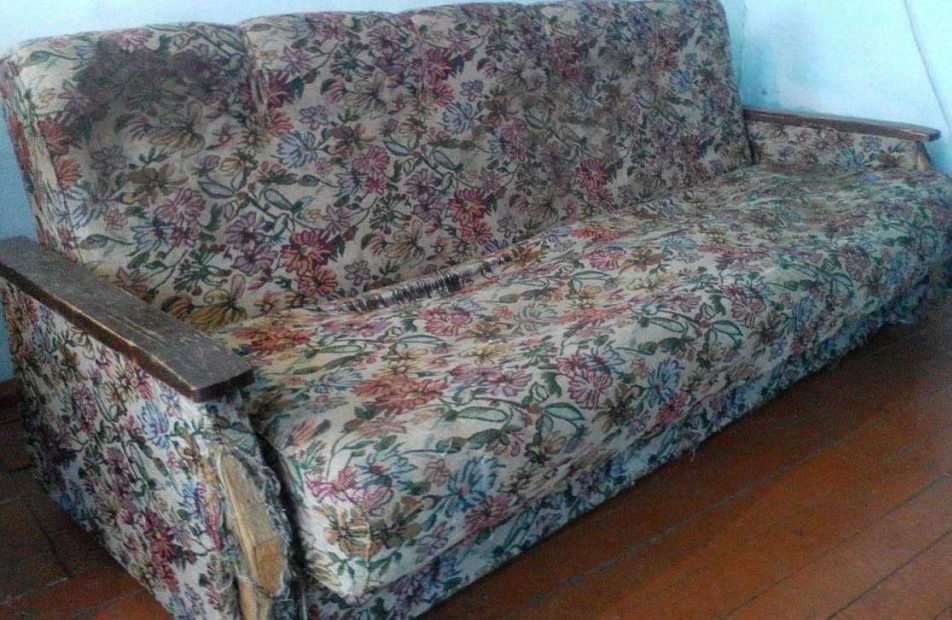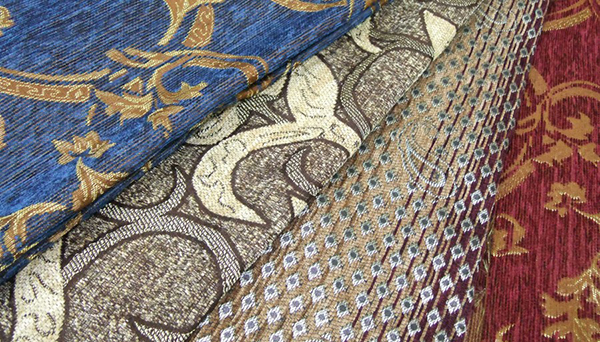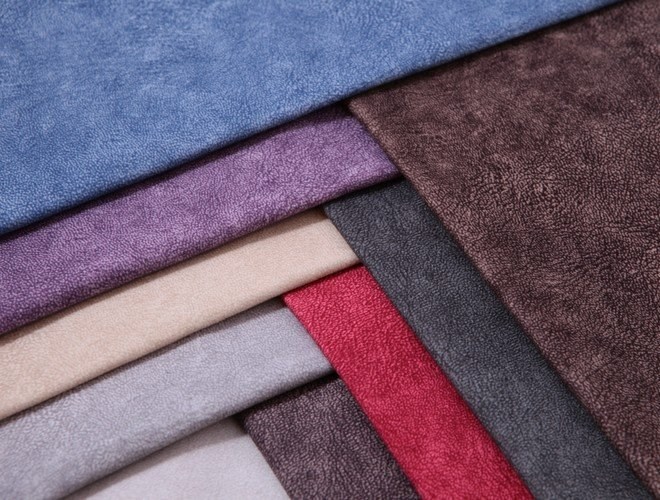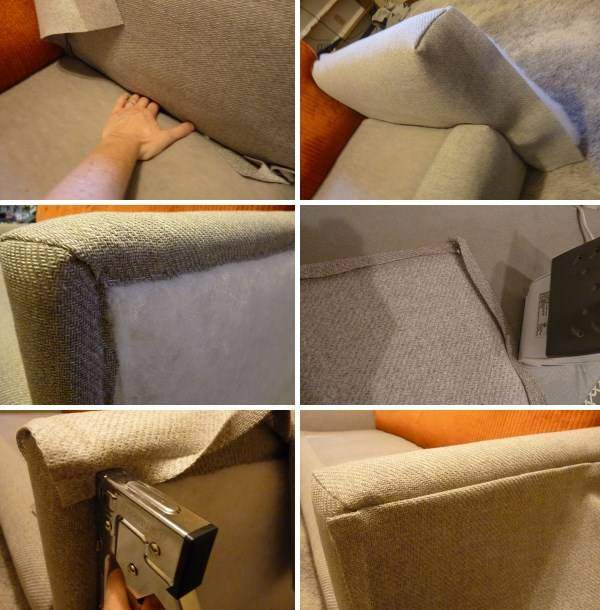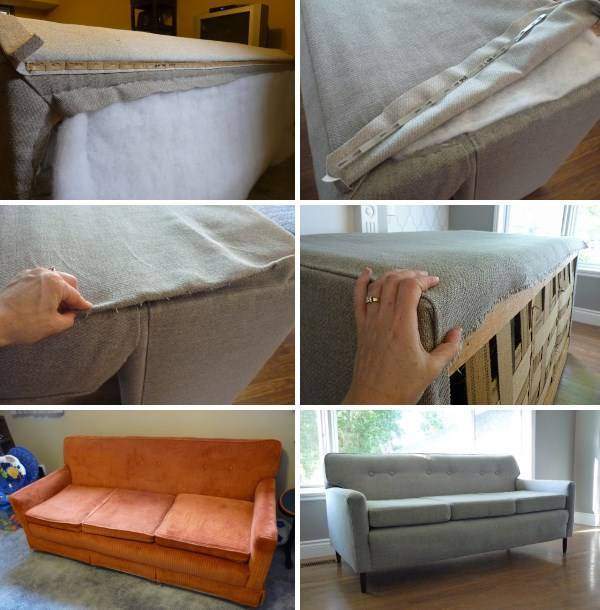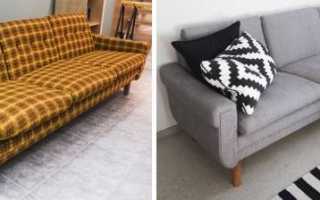Features of the restoration of the sofa with your own hands, a sequence of steps

The intense operational stresses that a sofa is subjected to every day in any family will inevitably lead to product wear. The design loosens, the upholstery is overwritten, the folding mechanism begins to play pranks - these are signals that it is time to restore your favorite furniture. When it is not possible to turn to specialists for help, restoration of the sofa with your own hands will also help to restore his gloss and comfort. Do-it-yourself repairs and upgrades save on the expensive services of professionals, while you can be 100% sure that all stages of restoration are done in good faith.
Content
What items are to be replaced
Before restoring the product, you should determine which parts need updating.. The wear process is accompanied by violations in the design and appearance of the product. Sometimes it is enough to update the upholstery, but most often all structural elements need repair and restoration. It’s time to restore the sofa if:
- The coating of fabric or leather faded, scuffs, tears appeared. Hidden under the upholstery, the filler has become less resilient, sagging seats have formed, in which case materials will need to be replaced.
- The design was shaken, the integrity of the internal fixtures was broken. The frayed frame is to be repaired, if the battens are cracked or broken, they will need to be replaced.
- It has become difficult to lay out and fold the sofa, efforts are required, the transformation mechanism is stuck. Problems can be associated with the deformation of the hardware or the weakening of the return springs - they will need to be replaced.
It is advisable to use components of the same manufacturer that were installed initially, otherwise an incomplete fit of parts and a quick failure of the mechanism are possible.
Necessary tools and materials
To restore the cover and the inside of the sofa, you will need upholstery fabric, filler, synthetic winterizer, non-woven. It is not necessary to use the same "filling" as it was. You can purchase higher quality and modern material.
Before you restore an old sofa with your own hands, you need to prepare the following tools and supplies:
- ring spanner or pliers;
- screwdriver;
- screwdriver set;
- a furniture stapler, a needle with a large eye, a strong nylon thread;
- tape measure, pencil, cutting chalk (or soap);
- universal adhesive (for fixing sheets of soft filler, repair of frame elements);
- self-tapping screws, metal dowels.
To process repaired parts from chipboard, sandpaper should be prepared. And to service the folding mechanism - a suitable lubricant for this.
Having no experience in calculating the material to replace upholstery and filler, you should not acquire it in advance. It would be more correct to go to the store after removing the old coating and its measurements.
Work stages
You need to approach each stage of the restoration of the sofa with your own hands with great responsibility, because even with minor errors the final result will be low. Repair takes several days, so it is recommended to place the furniture in a separate room. The procedure consists of a number of stages:
- preparation and disassembly of the worn product;
- marking and cutting material;
- tightness of soft seats and back;
- repair of the frame and metal elements of the folding mechanism;
- assembly of updated parts of the sofa.
To disassemble and assemble the sofa is easier and safer with an assistant.
Product preparation and disassembly
Work begins with a dismantling of the structure and an assessment of the extent of the restoration. Operations are carried out in the following sequence:
- Dismantled sidewalls with armrests (mounting bolts are located on the inside, to remove them you will need either a hexagonal wrench or pliers).
- The seats and backrest are removed. With retractable parts, they are also dismantled. After disassembling, it is necessary to check the condition of the frame elements for the presence of breaks or cracks on them. In the case of a folding sofa with a retractable sleeping unit, disconnect it.
When removing hardware elements, they should be laid out in separate packages and signed so as not to be confused with each other during assembly.
When the product is disassembled, you can begin to remove the old upholstery. To do this, all the brackets securing the material are carefully removed. Under the finishing fabric, several layers of felt or synthetic winterizer can be located, which are also removed for replacement. Next, you need to remove the filler, checking it for integrity and the possibility of reuse. If you need to replace it, you will need to approximately estimate the size, thickness and number of new plates.
If the furniture is more than five years old, it is inexpedient to leave the old filler when restoring the sofa, even if the foam looks intact and non-pressed.
The last to evaluate the condition of the springs. In the absence of bursting parts, play and cracks, as well as squeaking, restoration of this element will not be necessary. A good block can last for several decades.
Material selection
If you plan to upgrade the sofa with a minimum of costs, you should choose practical, inexpensive materials. As upholstery, furniture fabrics or eco-leather can be used. It should be borne in mind that the cost of leatherette is higher, and working with it is much more difficult than with materials on a woven basis. Fabrics used when hauling furniture should be wear-resistant, environmentally friendly, and practical. Great for:
- classic jacquard;
- shenill;
- inexpensive velor;
- flock;
- microfiber;
- tapestry.
Polyurethane foam, foam rubber, latex can be used as filler. Foam rubber is considered to be the cheapest offer; its average operational period is 3-5 years. It provides the required softness, but eventually loses its ability to restore its original shape. The best option when restoring a sofa with your own hands is latex.. It is characterized by environmental cleanliness, optimal elasticity, durability, porous structure eliminates the likelihood of mold. The only drawback is the high cost. Due to the good price-performance ratio, PPU is the most popular material. It is quite elastic, does not deform for a long time, provides a high level of comfort.
Repair items
In most cases, the transformation mechanism, the frame and the spring block are subject to restoration, the substrate, the casing material are replaced.Work with parts is carried out in the following sequence:
- Updating damaged or rotten frame elements. Heavily worn wooden blocks must be replaced with new ones, minor chips should be treated with a special composition to protect the wood. LDSP is the most fragile element: even in the case of small cracks, deflections on any part, it must be removed from the structure, and then install a new one.
- Repair, replacement of parts of the transformation mechanism. The latter in most cases is represented by metal elements that can only be deformed from a heavy load. A bent metal support should not be aligned, it is better to immediately replace it. The type of repair being carried out depends on the degree of damage. In case of slight deformation, it is enough to apply force with the hands towards straightening, strong defects are removed by welding or replacing the part. The spring-loaded folding mechanism, as a rule, does not need major repairs. Usually it is enough to slightly correct it, remove rust from all parts using WD, and if necessary, treat with machine oil or other lubricant.
- Updating the filler, fitting the elements with new upholstery. The filler is laid on a felt base, glued. Between him and the sheathing fabric, it is necessary to lay a synthetic winterizer or holofiber. Do-it-yourself restoration of upholstered furniture is often considered impossible precisely because of difficulties with covering, but with a neat, consistent approach, the result will be no worse than for professionals. When self-cutting upholstery fabric at the edges of the workpiece should leave a margin of about 5-10 centimeters. Size adjustment is made immediately after measuring the dimensions of the seat and back. It is necessary so that it is possible to arrange the hem of the material in the places of its attachment. The new upholstery should not be pulled too tight, step by step shooting the folded material every 8-10 cm.
To calculate the amount of fabric and the subsequent cutting of the new casing, take measurements from old covers.
Assembly
After repair or replacement of damaged elements, you can proceed to the assembly of the structure. The work is quite simple, as fastening is carried out with nuts, bolts, brackets, screws. Installation is carried out in the following sequence:
- The base is installed.
- The side parts are fastened - all fasteners must be well tightened, after the work is finished, creaking and play are unacceptable.
- The backrest is attached - it is important not to overtighten the fasteners.
- A seat is installed (restoration of sedaflex-type sofas, konrad is carried out in a slightly different order - the transformation mechanism is pre-installed, then the sleeping unit itself).
- The sides and decorative elements (if any) are hung last on the sofa.
The restored sofa is assembled in the reverse order of disassembly. Specialists are advised to beginners to carry out photofixation of each stage of dismantling.
Do-it-yourself sofas restoration is a complex, laborious process. You need to work carefully, paying attention to each stage, element. Do not ignore the recommendations of experienced craftsmen, because each "trifle" will affect the quality and appearance of the finished product.
Video


